Grow Strawberries at Home – imagine plucking juicy, sun-ripened strawberries straight from your own garden! Sounds like a dream, right? Well, it doesn’t have to be! For centuries, cultivating your own food has been a source of immense satisfaction and connection to nature. From ancient Roman rooftop gardens to the victory gardens of World War II, growing your own produce has always been a way to ensure fresh, healthy food and a sense of self-sufficiency.
But let’s be honest, not everyone has acres of land to dedicate to a sprawling strawberry patch. That’s where these clever DIY tricks and hacks come in! I’m going to show you how to grow strawberries at home, even if you only have a small balcony, patio, or even just a sunny windowsill.
In today’s world, where we’re increasingly conscious of where our food comes from and the impact it has on the environment, knowing how to cultivate your own delicious berries is more important than ever. Plus, store-bought strawberries simply can’t compare to the taste of freshly picked, homegrown ones. So, get ready to ditch the supermarket berries and embark on a rewarding journey of growing your own sweet treats! Let’s dive into some easy and effective DIY methods that will have you enjoying a bountiful harvest in no time.
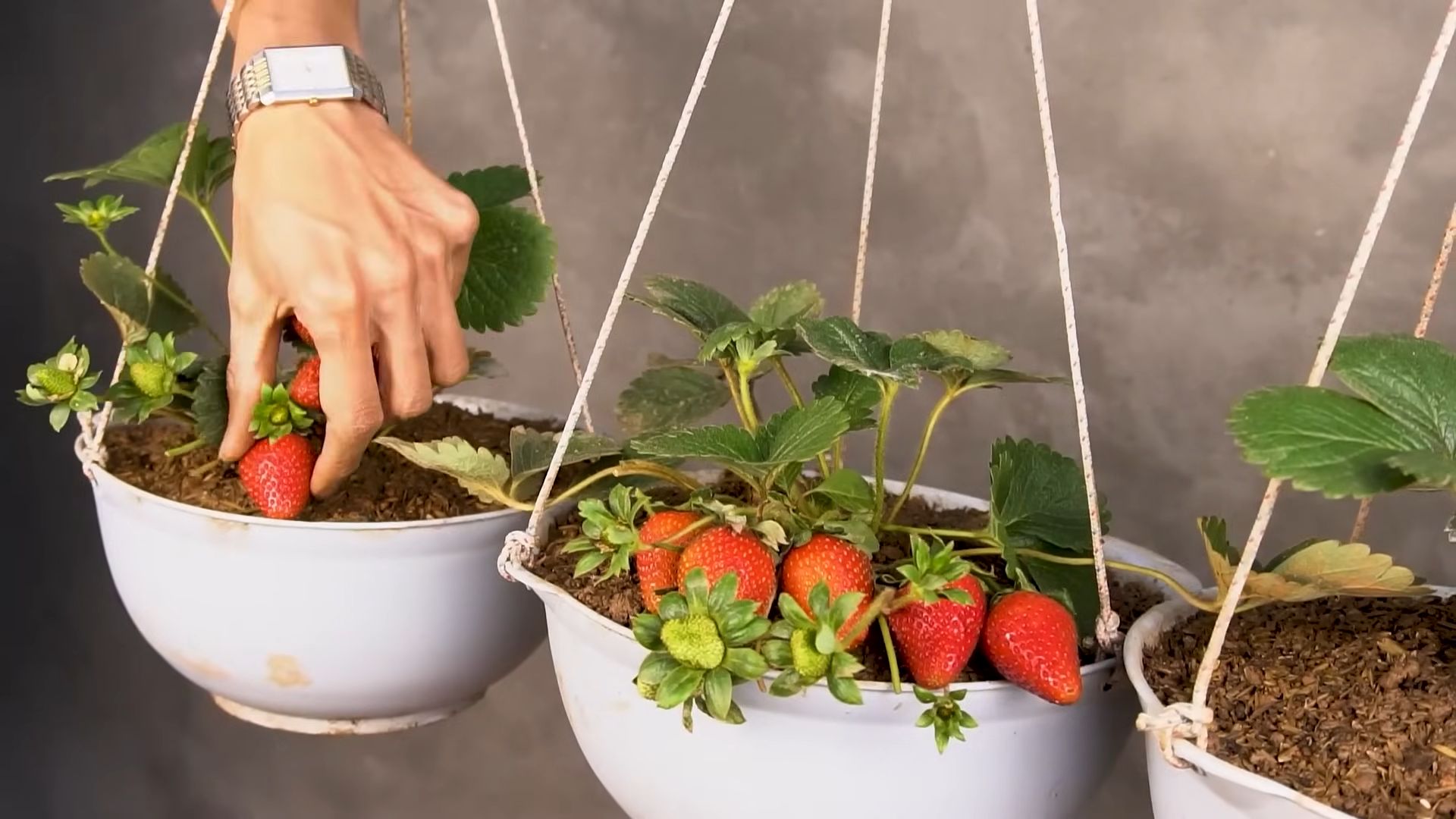
Grow Your Own Delicious Strawberries: A DIY Guide
Hey there, fellow gardening enthusiasts! Are you dreaming of fresh, juicy strawberries right from your backyard? Well, you’re in the right place! I’m going to walk you through everything you need to know to grow your own thriving strawberry patch, even if you’re a complete beginner. Trust me, there’s nothing quite like the taste of homegrown strawberries, and it’s a surprisingly rewarding project.
Choosing Your Strawberry Variety
Before we get our hands dirty, let’s talk about strawberry varieties. There are three main types, and each has its own unique characteristics:
* June-Bearing: These are your classic strawberries, producing one large crop in the spring, usually around June (hence the name!). They’re great if you want a big batch for jam-making or freezing.
* Everbearing: Don’t let the name fool you; everbearing strawberries don’t produce fruit continuously. Instead, they give you two or three harvests throughout the spring, summer, and fall. They’re a good choice if you want a more extended harvest period.
* Day-Neutral: These are the most consistent producers, fruiting throughout the growing season as long as the temperature is between 35°F and 85°F. They’re perfect for a steady supply of fresh berries.
Consider your climate and desired harvest schedule when choosing your variety. I personally love day-neutral varieties because I enjoy having fresh strawberries all summer long!
Preparing Your Strawberry Bed
Strawberries need a sunny spot and well-drained soil to thrive. Here’s how to get your garden bed ready:
1. Choose a Sunny Location: Strawberries need at least 6-8 hours of direct sunlight per day. Pick a spot in your yard that gets plenty of sunshine.
2. Test Your Soil: Strawberries prefer slightly acidic soil with a pH between 5.5 and 6.8. You can buy a soil testing kit at your local garden center or send a sample to your local extension office for professional testing.
3. Amend the Soil: Based on your soil test results, amend the soil as needed. If your soil is too alkaline, you can add sulfur or peat moss to lower the pH. If it’s too acidic, add lime.
4. Improve Drainage: Strawberries hate soggy roots, so good drainage is essential. If your soil is heavy clay, amend it with plenty of compost, well-rotted manure, or other organic matter to improve drainage.
5. Clear the Area: Remove any weeds, rocks, or debris from the planting area.
6. Till the Soil: Till the soil to a depth of at least 12 inches to loosen it up and make it easier for the strawberry roots to establish.
7. Add Fertilizer: Incorporate a balanced fertilizer into the soil before planting. Look for a fertilizer with an NPK ratio of 10-10-10 or similar. Follow the instructions on the fertilizer package for application rates.
Planting Your Strawberry Plants
Now for the fun part – planting! You can buy strawberry plants as bare-root plants or potted plants. Bare-root plants are typically cheaper, but potted plants are easier to establish.
1. Soak Bare-Root Plants: If you’re using bare-root plants, soak the roots in water for about 30 minutes before planting. This will help rehydrate them.
2. Dig Holes: Dig holes that are large enough to accommodate the strawberry roots. Space the plants about 12-18 inches apart in rows that are 3-4 feet apart.
3. Plant the Strawberries: When planting, make sure the crown of the plant (the point where the roots meet the stem) is level with the soil surface. Planting too deep can cause the crown to rot, while planting too shallow can dry out the roots.
4. Spread the Roots: Gently spread the roots out in the hole before backfilling with soil.
5. Water Thoroughly: After planting, water the strawberries thoroughly to settle the soil and help the roots establish.
6. Mulch: Apply a layer of mulch around the plants to help retain moisture, suppress weeds, and keep the berries clean. Straw, pine needles, or wood chips are all good choices.
Caring for Your Strawberry Plants
Once your strawberries are planted, it’s important to provide them with proper care to ensure a bountiful harvest.
1. Watering: Strawberries need consistent moisture, especially during fruit development. Water deeply whenever the top inch of soil feels dry. Avoid overhead watering, as this can promote fungal diseases. Drip irrigation is the best way to water strawberries.
2. Fertilizing: Fertilize your strawberries every 4-6 weeks with a balanced fertilizer. Avoid over-fertilizing, as this can lead to excessive foliage growth at the expense of fruit production.
3. Weeding: Keep your strawberry bed free of weeds, as they can compete with the strawberries for nutrients and water. Hand-pull weeds regularly or use a hoe to cultivate the soil.
4. Pest and Disease Control: Strawberries can be susceptible to various pests and diseases. Monitor your plants regularly for signs of trouble. Common pests include slugs, snails, and aphids. Common diseases include gray mold, leaf spot, and powdery mildew. Use organic pest control methods whenever possible.
5. Remove Runners: June-bearing strawberries produce runners, which are long stems that grow horizontally from the plant. These runners will root and form new plants. If you want to maximize fruit production, remove the runners as they appear. Everbearing and day-neutral strawberries produce fewer runners, so you don’t need to remove them as often.
6. Protect from Birds: Birds love strawberries just as much as we do! To protect your berries, cover your plants with netting or use bird repellent devices.
Harvesting Your Strawberries
The moment you’ve been waiting for – harvesting your delicious strawberries!
1. Harvest When Ripe: Strawberries are ready to harvest when they are fully red and slightly soft to the touch.
2. Pick Carefully: Gently grasp the berry and twist it off the stem. Avoid pulling or yanking, as this can damage the plant.
3. Harvest Regularly: Harvest your strawberries every few days to prevent them from becoming overripe and attracting pests.
4. Enjoy Your Harvest: Eat your strawberries fresh, use them in desserts, make jam, or freeze them for later.
Extending Your Strawberry Season
Want to enjoy strawberries for even longer? Here are a few tips for extending your strawberry season:
* Use Row Covers: Row covers can protect your strawberries from frost and extend the growing season in the spring and fall.
* Plant Different Varieties: Planting a mix of June-bearing, everbearing, and day-neutral varieties will give you a longer harvest period.
* Grow in Containers: Growing strawberries in containers allows you to move them indoors or to a sheltered location during cold weather.
Growing Strawberries in Containers
Don’t have a garden? No problem! You can easily grow strawberries in containers.
1. Choose the Right Container: Select a container that is at least 12 inches in diameter and 8 inches deep. Make sure the container has drainage holes.
2. Use a Good Potting Mix: Use a high-quality potting mix that is well-draining and contains plenty of organic matter.
3. Plant the Strawberries: Plant the strawberries in the container, making sure the crown of the plant is level with the soil surface.
4. Water and Fertilize: Water the strawberries regularly and fertilize them every 4-6 weeks with a balanced fertilizer.
5. Provide Sunlight: Place the container in a sunny location that gets at least 6-8 hours of direct sunlight per day.
6. Overwintering: In cold climates, you’ll need to protect your container strawberries from freezing temperatures. You can move them indoors to a cool, bright location or insulate the container with bubble wrap or burlap.
Propagating Strawberries
Want to expand your strawberry patch without buying new plants? You can easily propagate strawberries from runners.
1. Allow Runners to Root: Allow the runners to root in small pots filled with potting mix.
2. Separate the New Plants: Once the runners have rooted, cut them from the mother plant.
3. Transplant the New Plants: Transplant the new plants to their permanent location in the garden or in containers.
Troubleshooting Common Strawberry Problems
Even with the best care, you may encounter some problems when growing strawberries. Here are a few common issues and how to address them:
* Small Berries: Small berries can be caused by insufficient watering, poor soil fertility, or overcrowding. Make sure your strawberries are getting enough water and fertilizer, and thin out the plants if they are too crowded.
* Rotting Berries: Rotting berries
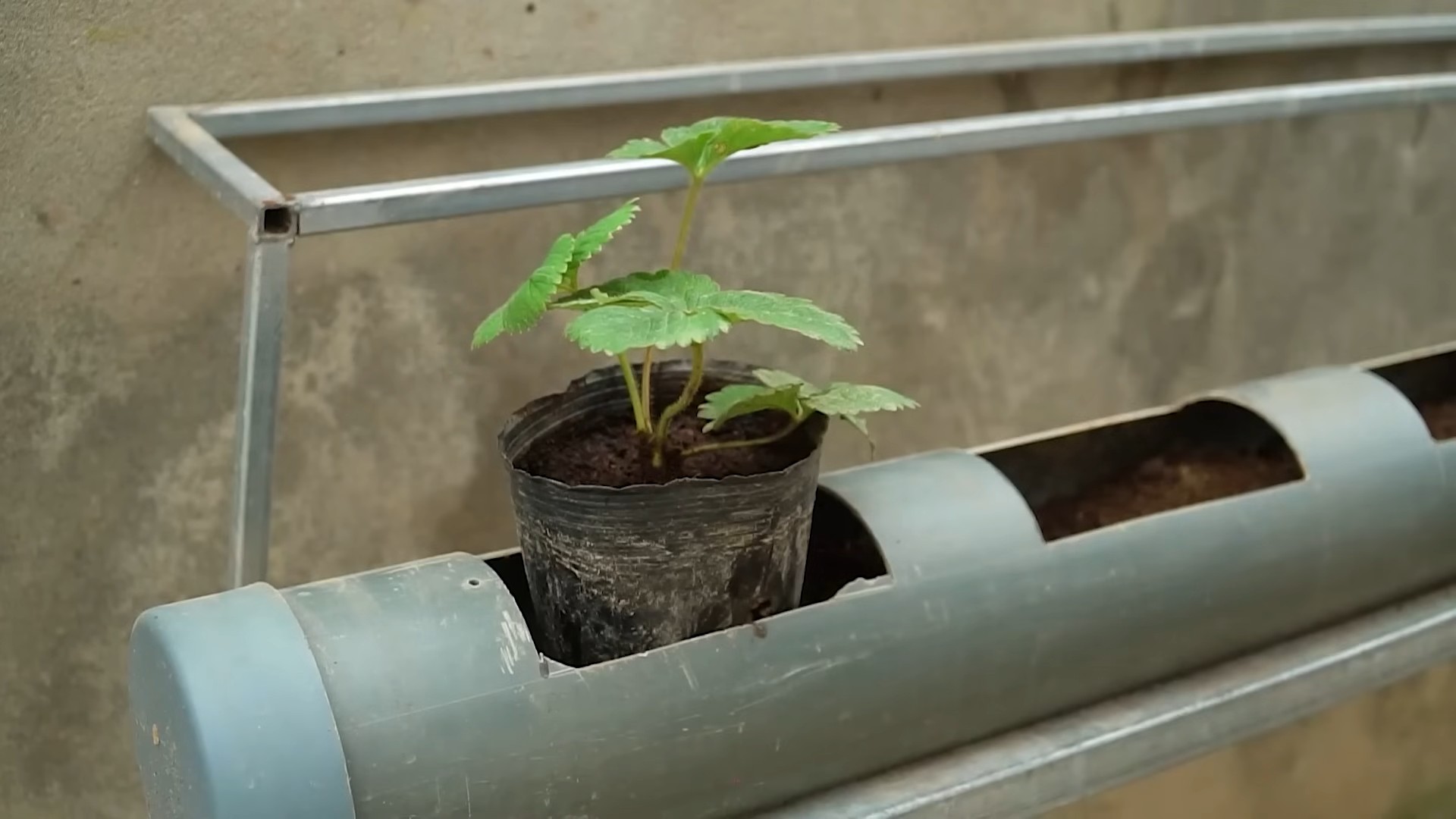
Conclusion
So, there you have it! Growing strawberries at home, especially using our simple DIY trick, is not just a gardening project; it’s an investment in fresh, flavorful, and healthy eating. Forget those bland, store-bought berries that lack the vibrant sweetness of homegrown fruit. With a little effort and our easy-to-follow method, you can transform your balcony, patio, or garden into a thriving strawberry patch.
Why is this DIY approach a must-try? Because it’s efficient, cost-effective, and incredibly rewarding. You’ll be amazed at how much you can save by growing your own strawberries, not to mention the satisfaction of harvesting your own delicious bounty. Plus, you have complete control over the growing process, ensuring that your strawberries are free from harmful pesticides and chemicals. This is especially important if you have children or are conscious about eating organic produce.
But the benefits don’t stop there. Growing strawberries at home is also a fantastic way to connect with nature, relieve stress, and learn new skills. It’s a project that the whole family can enjoy, from planting the seedlings to picking the ripe berries. And let’s not forget the sheer joy of biting into a sun-ripened strawberry, bursting with flavor that you can’t find anywhere else.
Looking for variations? Absolutely! Try experimenting with different strawberry varieties to find your favorites. Some popular choices include ‘Seascape’ for its everbearing nature, ‘Albion’ for its disease resistance, and ‘Honeoye’ for its early season yield. You can also adapt our DIY trick to suit your space and preferences. If you have limited space, consider using hanging baskets or vertical planters. For larger gardens, you can create raised beds or dedicated strawberry patches.
Another fun variation is to incorporate companion planting. Basil, thyme, and borage are all excellent companions for strawberries, as they help to deter pests and attract beneficial insects. You can also add a layer of mulch around your strawberry plants to help retain moisture and suppress weeds.
We’re confident that you’ll love growing strawberries at home using our DIY trick. It’s a simple, effective, and rewarding way to enjoy fresh, delicious berries all season long. So, what are you waiting for? Grab your supplies, follow our instructions, and get ready to harvest your own homegrown strawberries.
Don’t forget to share your experience with us! We’d love to see your strawberry patches and hear about your successes (and any challenges you encounter along the way). Share your photos and stories on social media using #HomegrownStrawberries and #DIYGardening. We can’t wait to see what you create!
Frequently Asked Questions (FAQ)
What is the best time of year to plant strawberries?
The best time to plant strawberries depends on your climate and the type of strawberry you’re growing. Generally, early spring or late fall are ideal. In warmer climates, fall planting allows the plants to establish roots before the heat of summer. In colder climates, spring planting gives the plants enough time to grow before the first frost. Everbearing varieties can be planted at either time.
What kind of soil do strawberries need?
Strawberries thrive in well-drained, slightly acidic soil with a pH between 5.5 and 6.5. Amend your soil with compost or other organic matter to improve drainage and fertility. Avoid heavy clay soils, as they can retain too much moisture and lead to root rot. A soil test can help you determine the pH and nutrient levels of your soil.
How much sunlight do strawberries need?
Strawberries need at least six to eight hours of direct sunlight per day to produce a good crop of berries. Choose a sunny location for your strawberry patch, and make sure that the plants are not shaded by trees or buildings.
How often should I water my strawberry plants?
Water your strawberry plants regularly, especially during dry periods. Aim to keep the soil consistently moist but not waterlogged. Water deeply and less frequently, rather than shallowly and more often. Mulching around your plants can help retain moisture and reduce the need for watering.
How do I fertilize my strawberry plants?
Fertilize your strawberry plants in early spring and again after the first harvest. Use a balanced fertilizer that is specifically formulated for berries. Follow the instructions on the fertilizer package carefully, and avoid over-fertilizing, as this can damage the plants. Organic fertilizers, such as compost tea or fish emulsion, are also excellent choices.
How do I protect my strawberries from pests and diseases?
Strawberries are susceptible to a variety of pests and diseases, including slugs, snails, aphids, and fungal infections. To protect your plants, practice good garden hygiene by removing dead leaves and debris. Use organic pest control methods, such as diatomaceous earth or insecticidal soap, to control pests. Ensure good air circulation around your plants to prevent fungal diseases. Consider using netting to protect your berries from birds.
How do I harvest strawberries?
Harvest strawberries when they are fully ripe and red. Gently twist the berry from the stem, leaving the green cap attached. Pick berries in the morning, after the dew has dried. Store harvested berries in the refrigerator for up to a week.
What are runners, and should I remove them?
Runners are long, slender stems that grow from the base of the strawberry plant. They are used to propagate new plants. If you want to expand your strawberry patch, you can allow the runners to root in the soil. However, if you want to maximize berry production, it’s best to remove the runners, as they divert energy away from fruit production.
Can I grow strawberries in containers?
Yes, strawberries grow very well in containers. Choose a container that is at least 12 inches deep and wide. Use a well-draining potting mix, and water regularly. Container-grown strawberries may need to be fertilized more frequently than those grown in the ground.
How do I overwinter my strawberry plants?
In colder climates, strawberry plants need to be protected from the winter cold. After the first frost, mulch around your plants with straw or leaves to insulate the roots. You can also cover the plants with a row cover or cold frame. In warmer climates, overwintering may not be necessary.

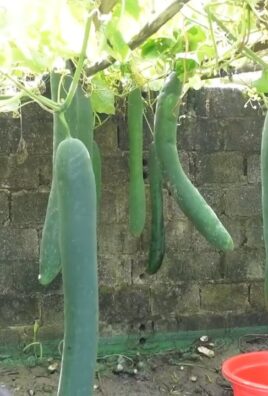
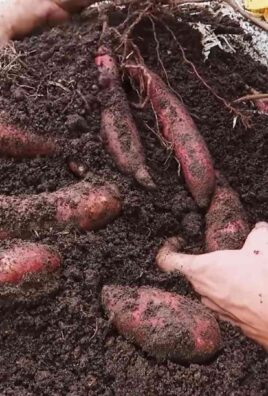
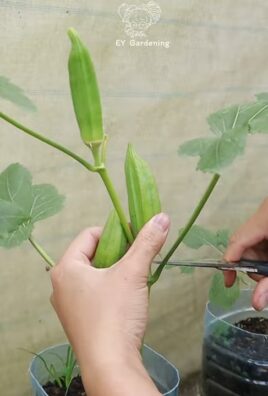
Leave a Comment